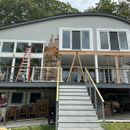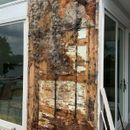Newer construction major sheathing rot over closed cell foam
Hello all,
We are seeking any kind of input on how to remedy this issue. We built our house in 2014 and have discovered major sheathing rot behind our siding. The rot is on the lake side of a home in Connecticut (western side of house). The home has boral true exterior v groove and boral true exterior trim installed over benjamin obdyke hydrogap, installed over 1/2″ CDX ply sheathing, installed over 2x6s, with closed cell spray foam between the 2x6s.
We had some rusty nails and warped trim which led us to pull some off. We discovered HUGE amounts of rot. Initially we thought that this was secondary to water intrusion along a couple of joints on the boral siding which had opened and were imperfectly caulked, however we have looked closer and the majority of the rot is nowhere near where there is water intrusion.
I suspect that water is getting in behind the siding, possibly through condensation, and then because the spray foam is closed cell any water that is trapped there stays there and rots the sheathing as the siding is tight and presumably the moisture cannot get out. When we installed the spray foam it was billed as the best insulation and came at the recommendation of our architect and builder.
Any input on how to remedy this situation would be greatly appreciated.
GBA Detail Library
A collection of one thousand construction details organized by climate and house part











Replies
User 661,
This is serious rot, and no one should jump to conclusions. The first question to answer is, "Where did the water come from?" I'm guessing you will want to use a blower door to check the envelope airtightness of your building -- and look carefully at the flashing details above the area with rot.
It might make sense to do some exploratory investigation (siding removal) on the other three orientations of your house. Probably this is a hard case to solve over the internet -- it needs a site visit with tools.
I found this JLC article that may help as you progress with your investigation:
https://www.jlconline.com/how-to/exteriors/installing-pvc-type-sidings-in-cold-climates_o
Excerpt: "WRB effectiveness. A laboratory study I conducted for a major supplier of wall WRBs tested the relative performance of walls with a regular, flat WRB, a crinkled WRB, and a rainscreen (with an air gap and a flat WRB). We tested each under wall leakage conditions where water was leaked into the tops of the wall cavities between the back of fiber-cement siding and the outside of the WRBs for four months. At the end of the test, the sheathing was very wet, moldy, and decayed on the wall with the flat WRB; somewhat less wet and moldy with no decay with the crinkled WRB; and completely dry and without mold or decay on the wall with the rainscreen. Many contractors are now selecting crinkled or other “drainable” WRBs, but that is not sufficient to prevent damage in walls with impermeable siding. The only prudent choice is to employ a rainscreen design to prevent major damage to walls with impermeable siding."
steve41,
Martin is our course right - we don't know what is causing this, but as a general proposition the JLC article appears to me to be spot-on. Drainable house-wraps are in no way comparable to rain-screens built with strapping, and can't be expected to handle moisture in the way they do.
thank you
What is your climate zone? A few years ago I consulted on a house with very similar issues. The only difference was Zip sheathing and a conventional WRB. Do you have details of how the window heads are flashed? Have you seen gaps between the spray foam and the framing? Do you know whether your house operates at positive pressure, neutral pressure or negative pressure?
Climate zone on the cusp of 5b/6a. The spray foam was tight against the framing and appeared in very good shape. Don't know about positive vs neutral vs negative pressure.
I'm with JLC on this.
Vertical siding does not direct water out like horizontal siding, The longer the run the more water is channeled behind. If this is the case, I would expect damage to be worse the further you go down which seems to be the case from the pictures.
The issue here isn't the SPF, if anything that has prevented your walls from turning into a moldy mess. The issue is the lack of proper gap, the drying capacity of that drain wrap is not meant to handle this much moisture ingress.
Proper solution is add a rain screen. Not easy though as there is a lot of re-trimming around the windows. Maybe add a break in the siding by adding a horizontal drip edge (lapped by the WRB from above) every 6'-8' to channel water out.
Boral is essentially impervious to water and has a pronounced tongue on the top. How do you propose that bulk water is getting through the cladding?
Michael,
You mention that Boral siding has a tongue on the top -- implying (I think) that the siding is being installed horizontally. But in this case, the siding is installed vertically.
Martin, somehow I missed that obvious fact, thank you.
Thanks for your response. I spoke to boral tech services who spoke with their engineer and they are recommending the same thing.
Deleted
Was there a 2nd floor deck that has been removed?
There were bracketed cable railings that were present in front of the sliders on the second story that were pulled. There was a gap between two pieces of boral trim that allowed for water intrusion and caused some water damage to the LVL's below the doors, we replaced the outer LVL.
User 661,
One possibility is that the contractor installed open-cell foam and told you it was closed-cell foam. Can you describe the consistency of the foam? Was it installed flush with the studs (i.e., trimmed flush) or was it installed with a bumpy surface, not quite even with the interior edges of the studs (as is typical of closed-cell foam)?
I'm in CT and was recently quote OC for the walls in my new garage. The insulation salesman recommended no vapor barrier. I told them no thanks.
Appeared to be closed cell foam as specified. Was sprayed less than proud to the stud cavity, was not trimmed flush, feels harder/denser than the open cell foam I have seen.
User 661,
Thanks. As you gather more data on this disaster, please keep GBA updated. We can all learn from cases like yours.
I'm wondering whether the decision to install the siding vertically allowed rain to get behind the siding. This doesn't explain the failure of the WRB, but it might be one part of the puzzle.